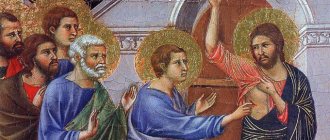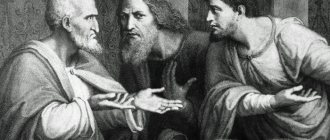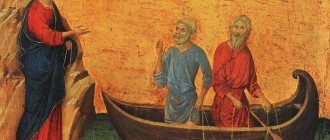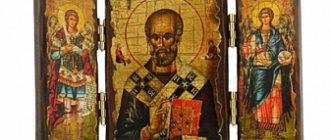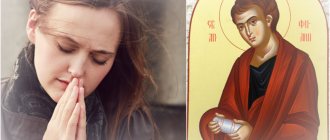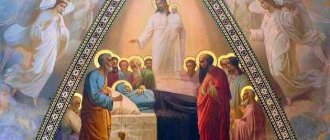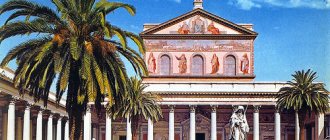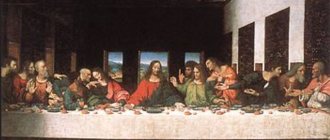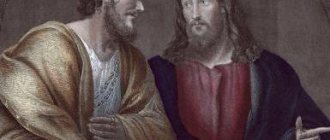The Apostle Peter is one of the very first disciples of Christ, standing out even among the first twelve followers of the Savior for his ardent faith and zeal in serving Him. And after Christ’s disciples set out on their apostolic path, Peter’s role in the spread of Christianity remained one of the most important. It is not surprising, therefore, that in Orthodox iconography the image of the Holy Apostle Peter occupies such a significant place.
Apostle Peter, monastery of St. Catherine, Sinai XIII century. Detail of the Deesis icon.
Childhood and youth
Not all facts of the biography of historical figures are known to descendants. So one can only guess about the date of birth of the Apostle Peter. But in the gospel traditions there is an indication of the place where the saint was born - Bethsaida of Galilee, a small town in Palestine. The region of Galilee was located farthest from Jerusalem. Its territory was inhabited mainly by pagans, who later became Peter’s first flock.
Painting "Saint Peter", Marco Zoppo
At birth the apostle received the name Simon. The name Peter, which is translated from Greek as “stone,” was called by Jesus for his special devotion, implying the foundation of the Church in a faithful follower of the teaching.
Peter was married to the niece of the Apostle Barnabas and raised a daughter and son. He earned his living by simple and unpretentious work - fishing on Lake Gennesaret. An occupation that did not bring much income required perseverance and patience.
The Gospels of Matthew and John tell different stories of how Peter met Jesus and came to believe in his teachings.
Painting "Andrew Leading Peter to Jesus", Caravaggio
According to one version, Simon was brought to Jesus by brother Andrew, who became a disciple of John the Baptist and learned from him about the Messiah. Jesus, looking at Simon, called him Cephas (in Aramaic - “stone”, Peter - in Greek). The stone is allegorically the faith on which the Church is built.
According to another, the Lord found the brothers while fishing on the shore of the lake, and addressed them with the words:
"Follow me. I will make you fishers of men."
Jesus showed the deep meaning of the phrase by filling the boats of Peter and Andrew to the brim with fish.
Jesus Calls Peter and Andrew
Researchers see no contradiction between the two narratives. They believe that Matthew emphasized the lives of ordinary people engaged in hard work. While John emphasized that long before meeting the Lord, the fishermen were spiritual, they listened to sermons and prepared for the coming of the Messiah.
Christian service
Peter did not immediately become imbued with apostolic ministry; he doubted his own capabilities and the power of the Lord. The Holy Scriptures present the apostle as a simple man, with his passions and weaknesses. For love and devotion, Jesus Christ allowed Peter to show them more often than others.
Apostle Peter and Jesus walk on water
Saint Peter is the only one of the disciples who, having recognized the Lord Jesus Christ walking on the sea, went to meet him on the water, but doubted the Divine help of the Teacher and began to drown, but was saved by the Lord, who reproached him for his lack of faith.
When Jesus predicted the coming suffering, Peter contradicted him here too, saying that it was impossible. The Apostle persuaded Christ to abandon the Way of the Cross, for which he called Peter “temptation and Satan,” since he thought “not about the things of God, but the things of man.” Saint Peter listened to the reproaches addressed to him and nevertheless did not abandon Christ.
Painting "Tears of St. Peter", El Greco
Peter, despite the fact that he often allowed his ardent temperament to take over, was always nearby, along with the apostles John and James, he formed an intimate circle of disciples. Jesus initiated Peter into the greatest secrets of his life. The Apostle witnessed the Divine glory on Mount Tabor, prayer in the Garden of Gethsemane, and Divine power during the resurrection of Jairus’s daughter by Christ.
Moreover, Peter was the only one when, when Jesus asked who his disciples thought he was, he answered without hesitation or delay: “You are the Christ, the Son of the living God,” thereby pronouncing the main postulate of faith.
Jesus Christ and the Apostle Peter
The turning point in the life of Saint Peter, again the only one of the apostles, was his threefold denial of the Son of God. After Judas' betrayal, Jesus was arrested and interrogated in the high priest's house. Three servants noticed the apostle and said that he was one of Christ’s disciples. Peter, fearing for his life, responded to each statement that he did not know Jesus. At this time, a cock crow was heard, the saint remembered the Teacher’s prophecy and left the house in tears, bitterly repenting of what he had done.
Some theologians interpret the apostle's reaction to the words of the servants as a manifestation of the weakness of the human spirit, and the rooster's crow as the voice of God, which does not allow one to relax and constantly reminds one of the purity of conscience.
Painting "The Denial of Peter", Caravaggio
By his own example, the first of the apostles saw how easily one could become the last. But the Lord forgave his beloved disciple when he also repented three times, restored him to apostolic rank and entrusted him with his flock, in other words, to teach the people the Christian faith.
Moreover, Christ entrusted the apostle, who committed a grave sin, with the keys to the Kingdom of Heaven, making him a mediator between people and God, giving him the right to decide whose souls are worthy of going there. This emphasizes that through repentance, selfless service and pure faith, the truth is learned and the gates of Paradise are opened.
After the miraculous Resurrection, Christ first appeared to Peter. After the Ascension of the Savior, Peter, as the chief among the apostles, became the first teacher and preacher of the word of God.
Resurrection of Christ
At the same time, the saint understood perfectly well that love and faith would have to be paid for with peace and life; the crucifixion of the Son of God, which he observed, is a clear example of this. Martyrdom was a kind of condition of apostleship. But at the same time, Peter acquired miraculous power, similar to that characteristic of his Teacher.
After the events of Holy Pentecost, when, together with other disciples, Peter accepted the grace of the Holy Spirit, the apostle began his ministry. Thanks to his first sermon, three thousand people joined the Christian community.
He turned into a tireless and undaunted preacher of the gospel teaching, began to show miracles: he killed the married couple Ananias and Sapphira with a word for lies and sacrilege, raised a girl named Tabitha, met a lame man at the temple, and restored the ability to walk.
Painting "St. Peter Heals the Sick with His Shadow", Masaccio
Even the shadow of a saint could cure illnesses: when the apostle walked down the street, the sick were taken out of their houses so that the shadow that fell on them would bestow healing. When, by order of King Herod, Saint Peter was imprisoned, an angel appeared at night and freed the apostle from prison.
At first Peter preached among the Jews. But then a revelation came to the apostle, people came with an amazing story that an angel appeared to one pagan and ordered him to invite Simon, who is called Peter.
“He will speak words by which you and your whole house will be saved.”
The saint shared the news with the other apostles, who regarded it as a sign that it was necessary to carry the faith of Christ not only among Jews, but also among other pagans. The first pagan to be baptized was the Roman centurion Cornelius and members of his family.
Fresco "Apostle Peter resurrecting Tabitha", Masolino
However, the apostle Paul later said that he was “entrusted with the gospel to the uncircumcised, as Peter was to the circumcised.” It was assumed that Peter, a native of Galilee, had difficulty with the foreign languages spoken by representatives of different nations living in the Eastern Mediterranean. Accordingly, converting non-Jews to Christianity is Paul’s task.
Church historians count six apostolic journeys of Peter. The Apostle preached in Judea and Samaria (the modern West Bank), Syria and Antioch (here the word “Christians” first appeared), in the territory of modern Turkey and Greece, in Rome and Babylon, Troy and Bithynia. Peter ordained the most faithful disciples as bishops.
Icons of the Apostle Peter
Legend says that, having left Jerusalem, the apostle lived for twenty years in the Eternal City, where he headed the Church. While in Rome, Saint Peter exposed Simon the Magus, who did not accept baptism with a pure heart and pretended to be Christ. The Prologue and the Great Menaion-Chetya describe the deeds that Simon and Peter cited as proof of their strength. With the help of the prayer of Christ, the apostle resurrected a young man from the royal family, but Simon only managed to make him turn his head.
At the direction of the saint, the dog spoke in human language. Then Simon, threatening the people of Rome, promised to ascend to heaven and did this with the help of demonic powers. Peter turned to Jesus for help, praying that the demons would leave the sorcerer. Simon fell and was killed. And the citizens of Rome, observing the events, believed in the one God preached by Peter.
St. Peter's Basilica in Vatican
In his letters to new converts, the saint taught not to be afraid of threats and persecution, not to abandon Christian foundations to please the pagans, and to denounce false prophets who do not understand the principles of Christian freedom and deny the essence of the Savior.
St. Peter's sermons are not just reasoning, but specific instructions, also presented in simple language. The Apostle calls to treat each other with respect, to love one’s neighbor, because love atones for sins, to fear God, and not to encroach on the property of others.
“As long as none of you suffers as a murderer, or a thief, or a villain, or as someone who encroaches on someone else’s property; and if you are a Christian, then do not be ashamed, but glorify God for such a fate.”
For two thousand years now, turning in prayer to the icons of the Supreme Apostle Peter, people have been asking for firmness in faith, for the return to the fold of the Church of those who have fallen into sects, for help in studying and for recovery from illnesses.
Death
The last place of the earthly life of the Apostle Peter was Rome. An angel informed the saint that death awaited him in this city, and Peter received the news with gratitude. With the help of the apostle, the beloved concubines of Emperor Nero believed in Christ and decided to lead a chaste lifestyle. By order of the Roman governor, Peter was captured.
Painting "The Death of the Apostle Peter", Caravaggio
The apostle persuaded the executioners to crucify him upside down, because he considered himself unworthy to die in the same way as the Son of God. Therefore, the inverted crucifix is called the Peter's Cross. The estimated day of death of the saint is June 29 according to the Julian calendar. Saint Peter was buried on the slope of Vatican Hill by his disciple Clement of Rome.
There is a legend that, before falling into the hands of the Romans, Peter intended to leave the city, but on the way he met a vision of Christ. The Apostle asked where he was going, and received the answer that the Savior was going to Rome to allow himself to be crucified again. Peter was ashamed and returned.
Painting "Lord, where are you going?", Annibale Carracci
For the Russian Orthodox Church, Peter's Day falls on July 12th. Special services are held in churches: the day before there is an all-night vigil, and in the morning there is a liturgy. Those who wish to receive communion are introduced to the mysteries of Christ. In Rus', Peter's festivities began on this day; in addition to the day of remembrance, Peter and Pavel Ryabinnik were honored on September 23.
What is asked of the icons of Peter and Fevronia of Murom
Peter and Fevronia, as has been repeatedly mentioned, are the patrons of the family hearth and family Orthodox values. They themselves were role models and it was their right to mentor both young and experienced families on the difficult path of life. When difficult trials come, when someone cannot stand it and goes astray, violating family commandments, when there is no strength to hope for the best, it is then that they turn to Saints Peter and Fevronia.
What should you pray for in front of the icon:
- instruct, help a young family, walk hand in hand throughout life;
- guide and return the unfaithful spouse to the family;
- save a family that is experiencing a relationship crisis;
- bring some sense into a cruel, unjust husband/wife;
- help maintain fidelity to marriage vows, return to the true path;
- about the health of family members;
- heed the request for the birth of children;
- send a righteous, pious person with whom you can create a proper Orthodox family.
The main condition for saying a prayer is sincerity, faith in the Lord and humility. Remember that all troubles only test you, make you stronger and prepare you for eternal life.
Memory
- 1511-1514 – Raphael, “The miraculous release of the Apostle Peter from prison”
- 1592 – El Greco, “The Apostles Peter and Paul”
- 1601 – Caravaggio, “The Crucifixion of St. Peter”
- 1610-1612 – Rubens, “The Apostle Peter”
- 1626 – St. Peter's Basilica in Rome
- 1703 – city of St. Petersburg (“city of St. Peter”)
- 1732 – Peter and Paul Cathedral in St. Petersburg
- 1762 – Gabriel Kozlov, “Apostle Peter denies Christ”
- 1888 – Church of the Apostle Peter in Jaffa (Israel)
- 1910 – Nikolai Gumilyov, “The Gates of Heaven”
- 1962 – Nunoike Cathedral (Japan)
- 1990 – Washington Cathedral (Cathedral of Saints Peter and Paul)
Troparion, kontakion, magnification
Troparion, tone 4:
Mother of the Apostles and universal teacher, pray to the Lord of all to grant greater peace to the universe and great mercy to our souls.
Kontakion, voice 2:
Firm and divinely preached preachers, the top of Thy apostles, O Lord, Thou didst accept into the enjoyment of Thy good things and peace: for Thou didst accept sickness and death more than all fruitfulness, the One who knows the heart.
Greatness
We magnify you, Christ's apostles Peter and Paul, who enlightened the whole world with your teachings and brought everything to Christ.
